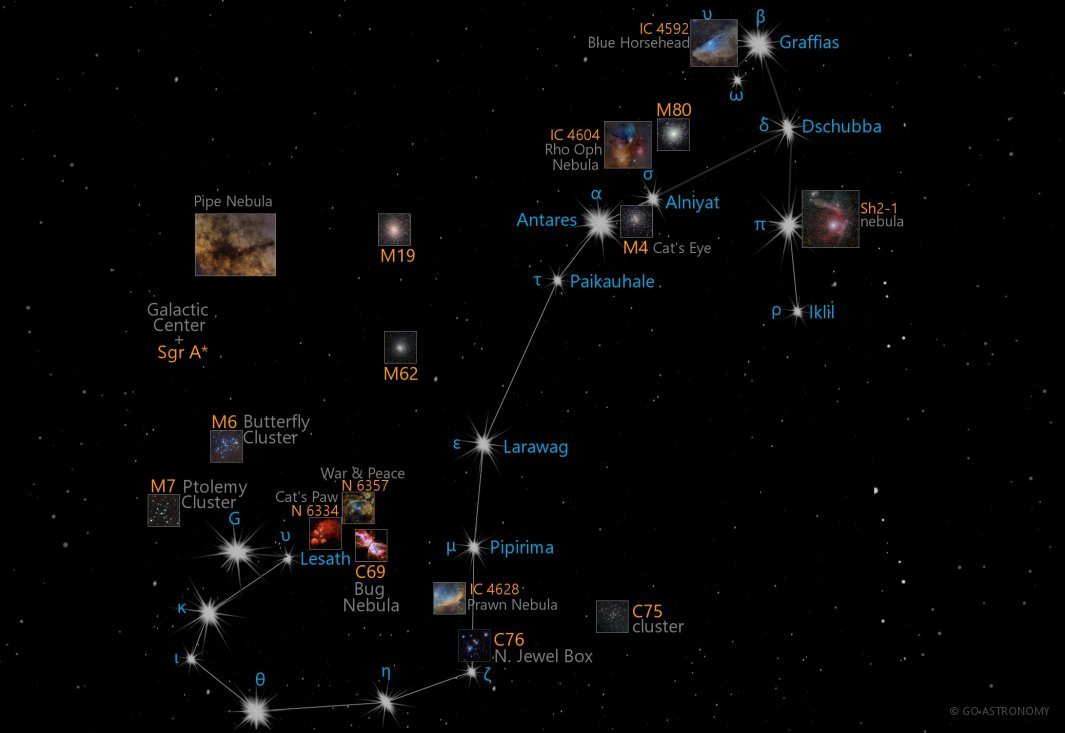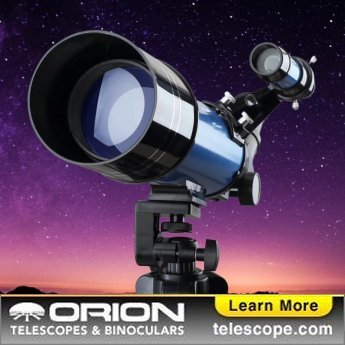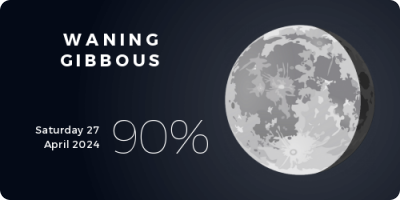Scorpius, the Scorpion (Sco)
(SCOR-pee-us)
The Southern constellation of Scorpius, the Scorpion, is best viewed in Summer during the month of July.
Scorpius is the 33rd largest constellation. It's brightest star is Antares at magnitude 0.96. The boundary of the Scorpius constellation contains 17 stars that host known exoplanets.
Red hypergiant AH Scorpii is the 8th largest known star in the universe at 1,400 times the size of the Sun.
- Pronunciation:
- SCOR-pee-us
- Meaning:
- Scorpion
- Genitive:
- Scorpii
- Abbreviation:
- Sco
- Asterism:
- Fish Hook
- Constellation Family:
- Zodiacal
- Hemisphere:
- Southern
- Quadrant:
- SQ3
- Visibility:
- 40° N - 90° S
- Best viewing month*:
- July
- Area:
- 497 sq. degrees
- Size:
- 33rd largest
- Right Ascension (avg):
- 16h 52m
- Declination (avg):
- -33°
- Brightest star:
- Antares (0.96)
- Stars with planets:
- 17
- X-ray stars:
- stars
Brightest Stars in Scorpius
The 10 brightest stars in the constellation Scorpius by magnitude.
- Star
- Magnitude
- Spectral class
- Alpha Scorpii (α Sco)
- 0.91
- M1.5Iab-b
- Lambda Scorpii (λ Sco)
- 1.62
- B2IV+DA7.9
- Theta Scorpii (θ Sco)
- 1.86
- F1II
- Delta Scorpii (δ Sco)
- 2.29
- B0.2IVe
- Epsilon Scorpii (ε Sco)
- 2.29
- K2IIIb
- Kappa Scorpii (κ Sco)
- 2.39
- B1.5III
- Beta Scorpii (β1 Sco)
- 2.62
- B0.5V
- Upsilon Scorpii (υ Sco)
- 2.7
- B2IV
- Tau Scorpii (τ Sco)
- 2.82
- B0V
- Pi Scorpii (π Sco)
- 2.89
- B1V + B2V
Double Stars in Scorpius
These are the brightest and easiest-to-find double, triple, and quadruple star systems in the constellation Scorpius. Also see all star clusters.
- Star system
- Magnitudes
- Type
- Xi Scorpii
- 4.9, 7.3
- double
- Struve 1999
- 7.5, 8.1
- double
- Beta Scorpii
- 2.6, 4.5
- double
- Nu Scorpii
- 4.4, 6.6
- double
Star Clusters in Scorpius
The most notable and easy-to-find star clusters in the constellation Scorpius . Also see all star clusters.
- Star cluster
- Catalog #
- Cluster type
- Butterfly Cluster
- M6
- open
- Caldwell 76
- C76
- open
- Djorgovski 1
- globular
- ESO 452-SC 11
- globular
- FSR 1758
- globular
- Messier 4
- M4
- globular
- Messier 80
- M80
- globular
- NGC 6139
- globular
- NGC 6144
- globular
- NGC 6242
- open
- NGC 6256
- globular
- NGC 6281
- open
- NGC 6380
- globular
- NGC 6388
- globular
- NGC 6441
- globular
- NGC 6453
- globular
- NGC 6496
- globular
- Ptolemy Cluster
- M7
- open
- Terzan 2
- globular
- Terzan 3
- globular
- Terzan 6
- globular
- Tonantzintla 2
- globular
Nebulae in Scorpius
Notable and easy-to-find nebulae in the constellation Scorpius . Also see all nebulae.
- Nebula name
- Catalog #
- Nebula type
- Bug Nebula
- C69
- planetary
- Cat's Paw Nebula
- emission
- Cotton Candy Nebula
- protoplanetary
- Fried Egg Nebula
- protoplanetary
- War and Peace Nebula
- diffuse
- Blue Horsehead Nebula
- reflection
Neutron Stars in Scorpius
These are the most well-known neutron stars in the constellation Scorpius. Although neutron stars cannot be seen in any amateur telescope, they are at the center of many supernova remnant nebulae, which can be seen. Also see all neutron stars.
Black Holes in Scorpius
These are the most well-known smaller (non-supermassive) black holes in the constellation Scorpius. Although black holes cannot be seen directly, the smaller ones are at the center of some star clusters and supernova remnant nebulae, which can be seen. Supermassive black holes are at the center of most galaxies, such as Sagittarius A* at the center of our Milky Way galaxy. Also see all black holes.
- Black hole
- Type
- IGR J17091-3624
- stellar
- V1033 Sco
- stellar
The Scorpion of the Sky
As one of the zodiac constellations, Scorpius stands prominently in the night sky with its distinct shape and brilliant stars. Known as 'The Scorpion,' Scorpius is a constellation steeped in mythology and rich in celestial objects.
Historical Background
Scorpius is among the 48 constellations documented by the 2nd-century astronomer Ptolemy, and it remains one of the 88 modern constellations recognized by the International Astronomical Union today. In Greek mythology, Scorpius is associated with the scorpion that killed the great hunter Orion. Hence, the two constellations are placed opposite each other in the sky, depicting the eternal chase between the hunter and the scorpion.
Location and Visibility
Scorpius lies in the southern hemisphere, surrounded by constellations such as Libra, Sagittarius, and Ophiuchus. During the northern summer and southern winter, Scorpius climbs high in the sky and is most visible. The constellation spans approximately 497 square degrees, and with many bright stars, it forms a noticeable pattern in the night sky.
Notable Stars in Scorpius
The brightest star in Scorpius is Antares, often referred to as the 'Heart of the Scorpion.' Antares is a red supergiant with an apparent magnitude of 1.09, giving it a fiery appearance in the night sky. Other notable stars include Shaula and Lesath, known as the 'Stinger Stars' at the end of the scorpion's tail, and Dschubba, which marks the scorpion's forehead.
Deep Sky Objects
Scorpius is rich in deep-sky objects, given its position near the plane of the Milky Way. Among the noteworthy features are the Butterfly Cluster (M6), the Ptolemy Cluster (M7), and the Cat's Eye Nebula (NGC 6337). Also located in Scorpius are the globular clusters Messier 4 and Messier 80, providing a rewarding experience for stargazers with a telescope at hand.
Observation
Observing Scorpius requires locating its bright star, Antares, which often twinkles with a reddish hue. The constellation is easily recognizable due to its prominent 'J' or 'S' shape, resembling the image of a scorpion. The best time for viewing Scorpius is during the summer months when it is high in the evening sky. As always, for the best viewing experience, it's advisable to observe from a location with minimal light pollution.
* Constellation shown for northen hemisphere skies. For the southern hemisphere, constellations appear rotated 180 degrees (upside-down and left-right reversed) from what is shown. Remember that seasons are reversed too - summer in northern latitudes is winter in southern latitudes.
** Circumpolar constellations are visible year-round in the hemisphere listed (and not at all in the opposite hemisphere).





